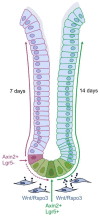The Role of Wnt and R-spondin in the Stomach During Health and Disease
- PMID: 31248166
- PMCID: PMC6631168
- DOI: 10.3390/biomedicines7020044
The Role of Wnt and R-spondin in the Stomach During Health and Disease
Abstract
The Wnt signaling pathway is one of the most prominent developmental signals. In addition to its functions in development, there is emerging evidence that it is also crucial for various organ functions in adult organisms, where Wnt signaling controls tissue stem cell behavior, proliferation and differentiation. Deregulation of Wnt signaling is involved in various pathological conditions and has been linked to malignant tissue transformation in different organ systems. The study of the Wnt signaling pathway has revealed a complex regulatory network that tightly balances the quality and strength of Wnt signaling in tissues. In this context, R-spondins are secreted proteins that stabilize Wnt receptors and enhance Wnt signaling. In this review we focus on new insights into the regulatory function of Wnt and R-spondin signaling in the stomach. In addition to its function in the healthy state, we highlight the connection between Wnt signaling and infection with Helicobacter pylori (H. pylori), a pathogen that colonizes the stomach and is the main risk factor for gastric cancer. In addition to experimental data that link Wnt signaling to carcinogenesis, we discuss that Wnt signaling is affected in a substantial proportion of patients with gastric cancer, and provide examples for potential clinical implications for altered Wnt signaling in gastric cancer.
Keywords: Axin2; Helicobacter pylori; Lgr5+ stem cells; R-spondin; Wnt signaling; gastric cancer; stem cells.
Conflict of interest statement
The authors declare no conflict of interest. The funders had no role in the design of the study; in the collection, analyses, or interpretation of data; in the writing of the manuscript, or in the decision to publish the results.
Figures


Similar articles
-
Stromal R-spondin orchestrates gastric epithelial stem cells and gland homeostasis.Nature. 2017 Aug 24;548(7668):451-455. doi: 10.1038/nature23642. Epub 2017 Aug 16. Nature. 2017. PMID: 28813421
-
R-spondin signalling is essential for the maintenance and differentiation of mouse nephron progenitors.Elife. 2020 May 1;9:e53895. doi: 10.7554/eLife.53895. Elife. 2020. PMID: 32324134 Free PMC article.
-
R-spondin-3 induces secretory, antimicrobial Lgr5+ cells in the stomach.Nat Cell Biol. 2019 Jul;21(7):812-823. doi: 10.1038/s41556-019-0339-9. Epub 2019 Jun 24. Nat Cell Biol. 2019. PMID: 31235935
-
Dysregulation of stem cell signaling network due to germline mutation, SNP, Helicobacter pylori infection, epigenetic change and genetic alteration in gastric cancer.Cancer Biol Ther. 2007 Jun;6(6):832-9. doi: 10.4161/cbt.6.6.4196. Epub 2007 Mar 26. Cancer Biol Ther. 2007. PMID: 17568183 Review.
-
R-spondins: Multi-mode WNT signaling regulators in adult stem cells.Int J Biochem Cell Biol. 2019 Jan;106:26-34. doi: 10.1016/j.biocel.2018.11.005. Epub 2018 Nov 12. Int J Biochem Cell Biol. 2019. PMID: 30439551 Review.
Cited by
-
RSPO3 Promotes Proliferation and Self-Renewal of Limbal Epithelial Stem Cells Through a WNT/β-Catenin-Independent Signaling Pathway.Invest Ophthalmol Vis Sci. 2025 Jan 2;66(1):8. doi: 10.1167/iovs.66.1.8. Invest Ophthalmol Vis Sci. 2025. PMID: 39760688 Free PMC article.
-
R-spondin/YAP axis promotes gastric oxyntic gland regeneration and Helicobacter pylori-associated metaplasia in mice.J Clin Invest. 2022 Nov 1;132(21):e151363. doi: 10.1172/JCI151363. J Clin Invest. 2022. PMID: 36099044 Free PMC article.
-
Gastric stem cells promote inflammation and gland remodeling in response to Helicobacter pylori via Rspo3-Lgr4 axis.EMBO J. 2022 Jul 4;41(13):e109996. doi: 10.15252/embj.2021109996. Epub 2022 Jun 29. EMBO J. 2022. PMID: 35767364 Free PMC article.
-
Responses of gastric epithelial stem cells and their niche to Helicobacter pylori infection.Ann Transl Med. 2020 Apr;8(8):568. doi: 10.21037/atm.2020.02.178. Ann Transl Med. 2020. PMID: 32775369 Free PMC article. Review.
-
The immune microenvironment in gastric adenocarcinoma.Nat Rev Gastroenterol Hepatol. 2022 Jul;19(7):451-467. doi: 10.1038/s41575-022-00591-0. Epub 2022 Mar 14. Nat Rev Gastroenterol Hepatol. 2022. PMID: 35288702 Free PMC article. Review.
References
Publication types
Grants and funding
LinkOut - more resources
Full Text Sources

